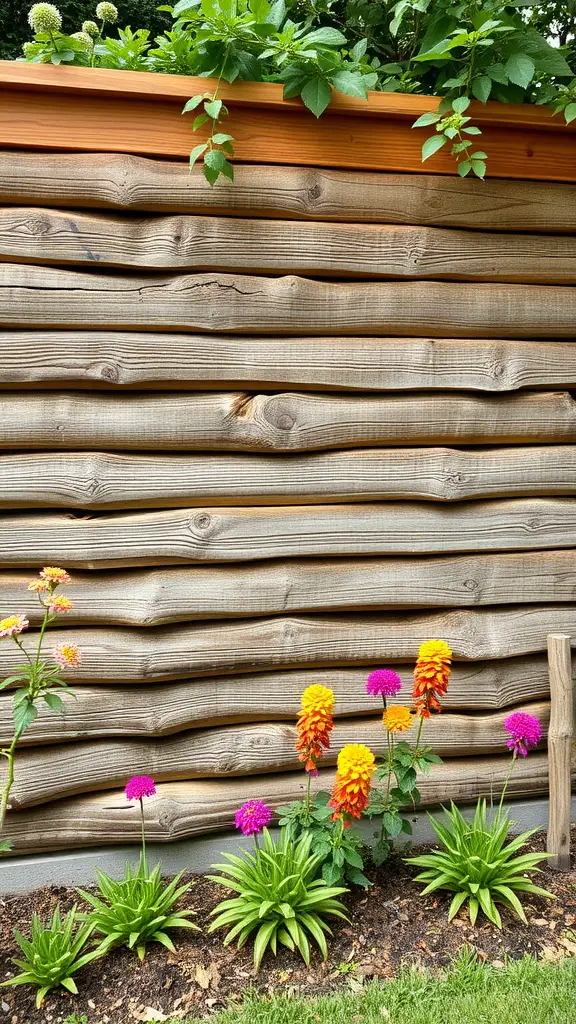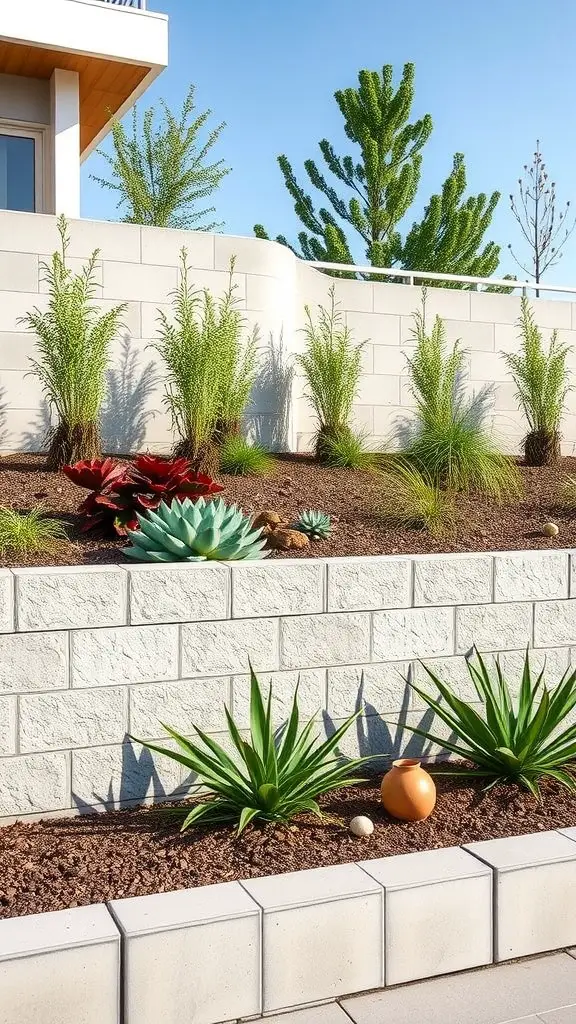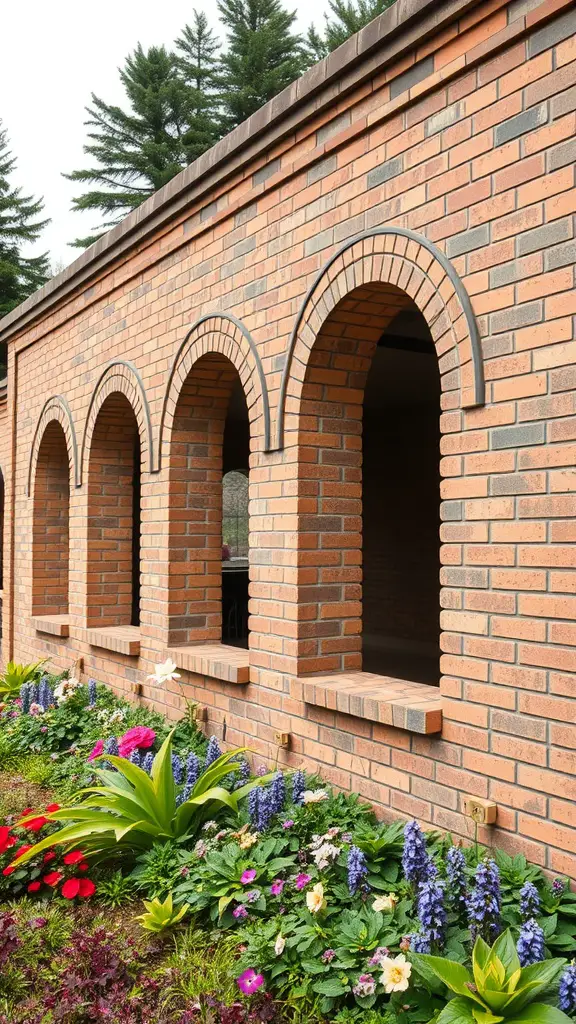If you’re looking to enhance your outdoor space without diving into a major landscaping project, small retaining walls can be a charming solution. They add structure, help with soil erosion, and can even elevate your garden’s style. Here are 27 inviting ideas to spark your creativity and inspire your next DIY project!
Timber Timber Retaining Walls

Timber retaining walls bring a natural look to your landscape while providing effective support for soil and plants. The image showcases a beautifully constructed timber wall, made from logs arranged in a wavy pattern. This design adds character and warmth to any garden space.
Incorporating timber can create a cozy atmosphere, as seen with the colorful flowers blooming at the base of the wall. The vibrant yellow, pink, and orange blooms contrast nicely with the earthy tones of the wood, creating a cheerful setting. It’s a simple way to enhance your garden’s aesthetic.
Maintaining a timber wall is relatively straightforward. Regular inspections for rot or damage are key. Treating the wood with preservatives can extend its lifespan. With a bit of care, these walls can last for many years, adding charm and functionality to your outdoor area.
Natural Stone Retaining Walls

Natural stone retaining walls offer a beautiful and functional solution for landscaping. They blend seamlessly into gardens, adding both charm and structure. The image shows a stunning example of this type of wall, made from various sizes of stones that create a rustic yet polished look.
The wall serves not just as a boundary, but also as a way to support soil and prevent erosion. It’s designed with a gentle curve that enhances the landscape, guiding the eye through the vibrant flowers and lush greenery. The combination of the stone and plants showcases how nature and hardscaping can work together harmoniously.
In addition to their aesthetic appeal, natural stone walls are durable and can withstand the elements. They require minimal maintenance, which is a big plus for busy homeowners. Adding elements like lighting, as shown in the image, can elevate the design even further, creating a warm ambiance for evening gatherings.
Concrete Block Retaining Walls

Concrete block retaining walls are a practical choice for both style and function. They can be used to create neat, tiered landscapes that enhance the overall appearance of your yard. In the image, you can see a well-designed wall made from concrete blocks, providing a solid structure while integrating beautifully with surrounding plants.
The wall in the photo is filled with greenery, showcasing how concrete blocks can serve as a backdrop for colorful plants, such as succulents and ornamental grasses. This combination not only adds visual interest but also helps in managing the slope of your garden.
One of the cool things about concrete block walls is their versatility. You can customize them in various heights and shapes, making them suitable for different spaces. They can be built to complement modern architecture or to fit into a more traditional garden setting. Plus, with the right landscaping, they can become a focal point in your outdoor area.
If you’re thinking about adding a concrete block retaining wall to your yard, consider how it will interact with your existing plants and structures. The design in the image highlights this well, as the wall supports the plants while creating a clean, organized look. It’s a great way to merge functionality with aesthetic appeal.
Cinder Block Retaining Wall with Planters

A cinder block retaining wall can be both functional and stylish. In this design, the wall doubles as a planter, adding greenery and color to any outdoor space. The blocks are arranged in a way that creates multiple levels, making it easy to plant various types of flowers and plants.
In the image, you can see a vibrant display of flowers, including pink and yellow blooms, which bring life to the cinder block structure. This not only enhances the visual appeal of the wall but also provides a great way to incorporate gardening into your landscape without taking up much ground space.
Using a cinder block wall for planters is also practical. It helps to manage soil erosion while offering a neat and organized look to your garden. Plus, the blocks can be painted or left in their natural state, allowing for plenty of customization options that fit your style.
Decorative Concrete Retaining Walls

Decorative concrete retaining walls can add both style and functionality to your outdoor space. As seen in the image, this wall features intricate designs that enhance the overall aesthetics of the garden. The textured surface catches the eye and complements the surrounding greenery.
Such walls are not just about looks, though. They serve crucial purposes, like preventing soil erosion and creating defined levels in your landscape. This example shows how a well-placed retaining wall can beautifully separate different areas of your yard.
Concrete offers versatility in design, allowing you to choose patterns and colors that match your style. The wall in the image has an elegant, classic look, fitting well in a more traditional landscaping setup. You can also opt for modern designs to give a fresh twist to your garden.
Incorporating plants and lighting, as shown, can further enhance the charm of a decorative retaining wall. The greenery softens the hard edges of the concrete, while the lamp adds a cozy touch. Overall, a decorative concrete retaining wall can be a stylish and practical addition to any yard.
Gabion Walls for Drainage

Gabion walls are a practical solution for managing drainage issues in your yard. Made from wire cages filled with stones, these walls not only hold back soil but also allow water to flow through. This helps to prevent erosion and manage water runoff effectively.
The image shows a sturdy gabion wall, constructed with various sizes of stones that create a visually appealing and functional structure. The natural look of the stones blends nicely with the surrounding environment, making it an attractive choice for landscaping.
When building a gabion wall, consider the area’s drainage needs. Proper placement can direct water away from your home and garden, reducing the risk of water damage. Plus, they can be stacked at different heights to create a unique landscape design.
Incorporating a gabion wall can also enhance the visual appeal of your outdoor space. You can even plant vegetation nearby to soften the look and further improve drainage. Remember, planning is key to ensure that your gabion wall serves its purpose effectively while looking good in your yard!
Brick Retaining Walls with Arches

Brick retaining walls with arches add a touch of elegance to any garden or landscape. The curves of the arches soften the rigid lines of the bricks, creating a welcoming look. This design not only serves a practical purpose but also enhances the aesthetic appeal of your outdoor space.
In the image, you can see a beautifully constructed brick wall featuring several arches. The combination of earthy brick tones and the green plants below creates a harmonious blend. The arches provide openings that can serve multiple functions, like allowing for drainage or simply creating a visual break in the wall.
Landscaping around these walls can elevate the overall design. Colorful flowers, like those shown in the image, can contrast nicely with the brick, bringing life to the structure. Consider planting low-maintenance perennials for a vibrant and continuous display throughout the seasons.
Tiered Retaining Walls

Tiered retaining walls are a beautiful way to manage elevation changes in your yard while creating distinct planting areas. In the image, you can see a series of stone walls arranged in steps, each level hosting a variety of plants and flowers. This design not only adds visual interest but also maximizes space for gardening.
The use of different plant types, like sunflowers and succulents, enhances the overall aesthetic. The layered approach allows for better drainage and soil retention, which is crucial for plant health. Plus, it’s a great way to keep your garden neat and organized.
These walls can be customized to fit any garden style. Whether you prefer a more rustic look with natural stones or a sleek modern design, tiered walls offer versatility in materials and arrangements. You can even incorporate built-in planters or seating areas for added functionality.
If you’re considering a tiered retaining wall, think about how it will work with your existing landscape. Plan out the plants and flowers you want to use, keeping in mind their growth habits and sunlight needs. This way, you’ll create a cohesive and thriving garden that enhances your outdoor space.
Recycled Materials Retaining Walls

Creating a retaining wall with recycled materials is a smart choice that’s both eco-friendly and appealing. In the image above, you can see a wall made from a variety of stones and tiles, showcasing how different textures and colors can blend together beautifully. This method not only helps reduce waste but also adds character to your outdoor space.
Using materials like reclaimed bricks, old tiles, or even pieces of wood can give your retaining wall a unique look. Each piece tells a story, and the mix of materials can make your garden feel special. Plus, these materials are often more affordable than brand-new options, making it easier on your wallet!
Building a wall from recycled materials also encourages creativity. You can experiment with patterns and arrangements, ensuring that your design is one-of-a-kind. Remember to consider the structural integrity of your wall as you select materials. It’s important to ensure that everything is sturdy and secure!
Overall, a recycled materials retaining wall is a fun project that enhances your garden while being kind to the planet. So gather your old materials, unleash your creativity, and watch your outdoor space transform.
Vertical Garden Retaining Walls

A vertical garden retaining wall is not just functional but also adds a touch of nature to urban spaces. The image showcases a beautifully designed wall made of sturdy blocks, lined with lush greenery and vibrant plants. This design is perfect for maximizing space, especially in smaller areas where horizontal gardening is limited.
The plants are arranged in well-defined sections, creating a visual flow that catches the eye. You can see a mix of herbs and decorative plants thriving in their containers, making this wall a delightful feature. If you enjoy gardening but have limited ground space, this idea is a fantastic way to bring life to your environment.
Adding a vertical garden to your retaining wall can enhance your property’s aesthetics while promoting biodiversity. It’s a simple yet effective way to contribute to a healthier environment. Plus, the plants can improve air quality and create a more serene atmosphere.
Curved Retaining Walls

Curved retaining walls add a unique touch to your landscape. They gently guide the eye through a garden, creating a sense of flow and movement. In the image, you can see how a softly curved wall complements the surrounding flowers.
This design not only helps with erosion control but also enhances the aesthetic appeal of your yard. The combination of stone and colorful blooms makes for a vibrant display. You can experiment with different plants to see what works best with your wall.
Curved walls can also be used to create distinct areas in your garden. They can define spaces for seating, pathways, or flower beds. The fluid shape contrasts nicely with straight lines often found in traditional landscaping.
Using a curved retaining wall invites creativity. You can integrate various plant types, creating layers of colors and textures. This not only beautifies your space but also encourages biodiversity.
Boulder Retaining Walls

Boulder retaining walls are a solid choice for adding both function and style to your landscape. The image shows a sturdy wall made of various sized boulders, showing how natural stone can blend beautifully with outdoor spaces. These walls not only hold back soil but also create a rustic look that enhances the overall aesthetic.
Using boulders as retaining walls has some unique advantages. They are durable and can withstand weather changes better than many other materials. Plus, they require minimal maintenance, making them a practical option for homeowners. The natural variation in stone size and color adds character to your garden or yard.
When planning for a boulder retaining wall, consider the surrounding landscape. You can plant low-growing shrubs or ground cover in front or between the stones to soften the look. This greenery can also help prevent soil erosion, adding another layer of functionality to your design.
Incorporating a boulder wall can create different levels in your garden, allowing for diverse planting options. You might also think about adding lighting to highlight the boulders at night. This simple touch can make your outdoor space feel inviting and cozy.
Metal Retaining Walls for a Modern Touch

Metal retaining walls are a stylish choice for any contemporary garden. They bring a sleek and clean look that fits well in modern landscapes. The image showcases a charming backyard featuring a metal wall that acts as a border for the garden space. This design not only provides practical support for soil but also enhances the overall aesthetic.
The contrast between the metal and the greenery adds depth to the garden. In the photo, you can see a variety of plants, including succulents, thriving along the wall. Their vibrant colors pop against the sleek surface of the metal, creating a visually appealing arrangement.
Using metal for retaining walls can also be quite functional. It’s durable and resistant to weather changes, meaning it will hold up well over time. This makes it an excellent choice for homes looking to maintain their landscaping without constant upkeep. Plus, the modern vibe of metal walls can complement various architectural styles.
Incorporating metal retaining walls can really elevate your backyard. They work well with different types of plants and landscaping designs. If you’re considering a modern touch for your outdoor space, this could be a great option to explore.
Painted Retaining Walls for Accent

Painted retaining walls add a splash of personality to any outdoor space. In the image, you can see a vibrant combination of orange and yellow hues that truly stand out. The lively colors contrast beautifully with the natural greenery and the cozy seating area in front of it.
This particular design not only serves its practical purpose of holding back soil but also creates a focal point in the garden. It transforms a simple structure into an eye-catching element that invites you to sit back and enjoy the view.
Pairing a painted wall with colorful furniture, like the blue and red chairs shown, enhances the cheerful atmosphere. This setup encourages relaxation and socializing, making it an inviting spot for family and friends.
When considering your own painted retaining wall, think about colors that reflect your style and complement your landscape. The right shades can turn a functional wall into a vibrant piece of art that adds character to your yard.
Stone Veneer Retaining Walls

Stone veneer retaining walls add a natural touch to your outdoor space. They blend beautifully with the landscape and can be designed to fit various styles, from rustic to modern.
The image showcases a well-crafted stone veneer wall, enhancing the steps leading up to a cozy patio area. Notice how the layers of stone create visual interest while also serving a practical purpose.
These walls are not just about looks; they help manage soil erosion and improve drainage. The layers of stone provide stability and structure, making them an excellent choice for sloped yards.
Incorporating planters at the top of the wall allows you to add greenery, making your space feel alive. You can mix in flowers or shrubs, bringing color and life to the design.
Maintenance is relatively simple. A quick wash with a hose can keep the stones looking fresh. Plus, because they are made of durable materials, they withstand the test of time.

We stumbled over here different website and thought I might as well check things out.
I like what I see so now i’m following you. Look forward
to looking into your web page again.
casino en ligne
hi!,I like your writing so so much! percentage we be in contact extra approximately your post on AOL?
I require a specialist on this house to solve my problem.
Maybe that’s you! Looking ahead to see you.
meilleur casino en ligne
I just couldn’t leave your site prior to suggesting that I really enjoyed the usual info a person supply on your guests?
Is gonna be again often to inspect new posts
casino en ligne
Hi there! Do you use Twitter? I’d like to follow you if that would be
okay. I’m definitely enjoying your blog and look forward to new posts.
casino en ligne
Do you mind if I quote a few of your articles as long as I provide credit and sources
back to your site? My blog site is in the exact same niche as yours and my users would definitely benefit from some of the information you present here.
Please let me know if this okay with you. Thanks!
casino en ligne
What’s up everyone, it’s my first go to see at this site,
and piece of writing is actually fruitful for me, keep up posting such content.
casino en ligne
Amazing blog! Is your theme custom made or did you download it from
somewhere? A design like yours with a few simple adjustements would really make my blog stand out.
Please let me know where you got your design. Appreciate it
casino en ligne France
You actually make it seem so easy with your presentation but
I find this topic to be actually something that I think I would
never understand. It seems too complicated and very broad for me.
I’m looking forward for your next post, I’ll try to get the
hang of it!
casino en ligne
Good respond in return of this question with real arguments and describing all on the topic of that.
casino en ligne
You really make it seem really easy along with your presentation but I to find
this matter to be really one thing which I believe I might never understand.
It seems too complicated and very wide for me.
I’m looking forward on your subsequent put up, I’ll try to get
the dangle of it!
casino en ligne